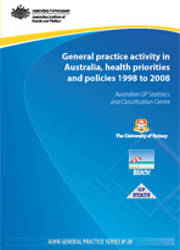Summary
This report looks at changes in the clinical activities of general practice in Australia over the decade 1998 to 2008, in the context of numerous government initiatives, changes in the general practitioner (GP) workforce and changes in the population.
General practice activities are measured by the Bettering the Evaluation and Care of Health (BEACH) program, a continuous national study based on data collected from new samples each year of about 1,000 GPs. Each GP provides details for 100 consecutive GP-patient encounters. BEACH began in April 1998 and this report uses data collected from then to March 2008, covering about 9,900 GP participants and 990,000 GP-patient encounters.
The report focuses on general practice activities for eight health conditions declared as National Health Priority Areas in recent times by the Australian and state and territory governments and two emerging health areas-sexual health and gastro-oesophageal reflux disease. It also summarises care provided to the Aboriginal and Torres Strait Islander population by GPs.
Australians and their GPs
- Both the Australian population and its GPs are ageing.
- GPs are spending an increasing proportion of their time with older patients and less with children.
- An increasing proportion of GPs are female (almost 4 in 10).
- Most GPs are in group practices; the average GP is working fewer hours.
- Based on the number of doctors and the hours they work, there has been an apparent GP shortage, and recognised geographic maldistribution.
- Over the period of 1998-2008, visits to GPs fell from a peak of 5.5 visits per head of population at the start to a low of 4.9 in 2003-04, then rose towards the earlier level to 5.2 in 2007-08.
General government measures
- To improve equity of access to GPs, the Australian Government took steps in 2004 and 2005 to increase certain GP payments and reduce patient costs.
- Government also encouraged GP management of chronic diseases, and increased preventive health checks among at-risk groups, by creating payment incentives through the Medicare scheme.
- Responding to the GP shortage, governments have created more training places, encouraged employment of doctors from overseas, and supported use of nurses to help GPs in their clinical work, by providing Medicare rebates for some nurse activities.
Why patients visit GPs and what GPs are doing
- The number of reasons patients give for seeing the GP have increased over time and changed, with a move towards more requests for services (such as check-ups and prescriptions) and away from descriptions of symptoms.
- GPs are more often doing check-ups and detecting and managing chronic diseases, such as diabetes, hypertension (high blood pressure) and other cardiovascular problems, cholesterol disorders and depression.
- They are increasingly likely to order pathology tests at a visit and to order more tests when they have decided to test.
Where has disease management improved?
There have been numerous special government initiatives over the decade, and some new clinical guidelines, aiming to help GPs improve their management of a range of priority health problems. The initiatives have mainly been to ensure that GPs are appropriately reimbursed when they adopt what are considered to be best practice methods of clinical care. This is done by devising new items for services that can be claimed under the Medicare scheme. The causal effect of policies is often difficult to assess because of the complexity and breadth of general practice, and because some policies have been in existence longer than others, having less time to have had an effect. However, this report has shown that GP clinical activity generally correlates strongly with health policy initiatives
Positive developments include increased:
- detection and management of Type 2 diabetes
- involvement in detecting and managing cancers of the breast, cervix, skin and prostate, suggesting greater sharing of responsibility with specialists for the care of these problems
- referrals of psychological problems to psychologists but no decrease in GP involvement in management, again suggesting more sharing of care between these professions
- use of asthma maintenance therapy for adults, in line with recent policies and guidelines
- prescribing of the cholesterol-lowering statin drugs and monitoring of patients' cholesterol levels, particularly those at risk through Type 2 diabetes, in line with guidelines for reducing the risk of heart disease and stroke.
So far there has been no measurable impact of policies on:
- multidisciplinary team management with, and use of, allied health professionals by GPs in the management of priority health areas, except for psychological problems and Type 2 diabetes
- management of arthritis and other musculoskeletal conditions, except osteoporosis
- management of heart disease and stroke, except for cholesterol-lowering activities, though the lack of an increase in the incidence of stroke in an ageing population suggests better preventive care
- how health problems among Aboriginal and Torres Strait Islander patients are managed.
And the study raises concerns about:
- the cost of the continued rapid growth in the ordering of pathology testing
- an increase in the management rate of adverse medical events in older patients and younger women
- the increasing number of patients who will be diagnosed with complex health needs, the time that will be needed to care for them and the effect this will have on the future GP workforce.



